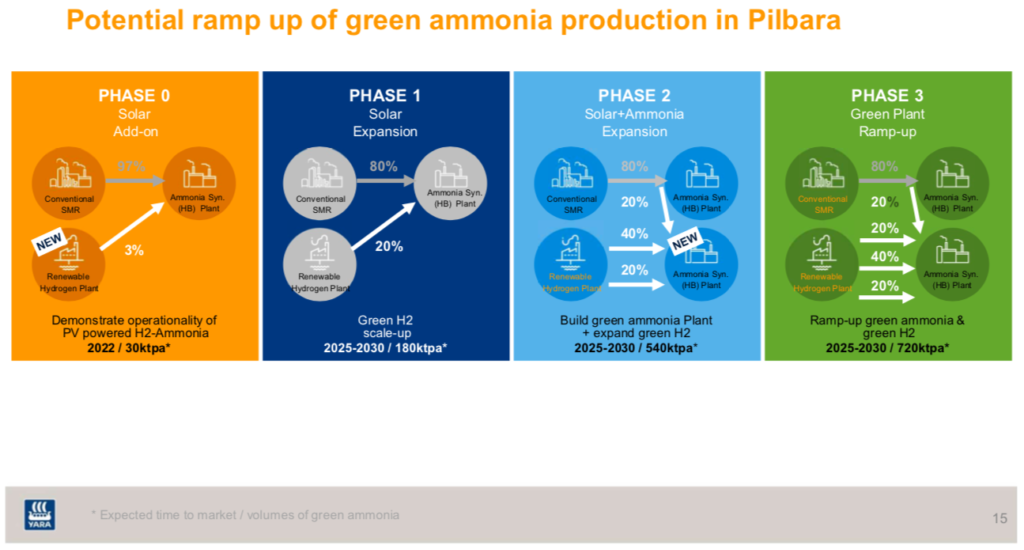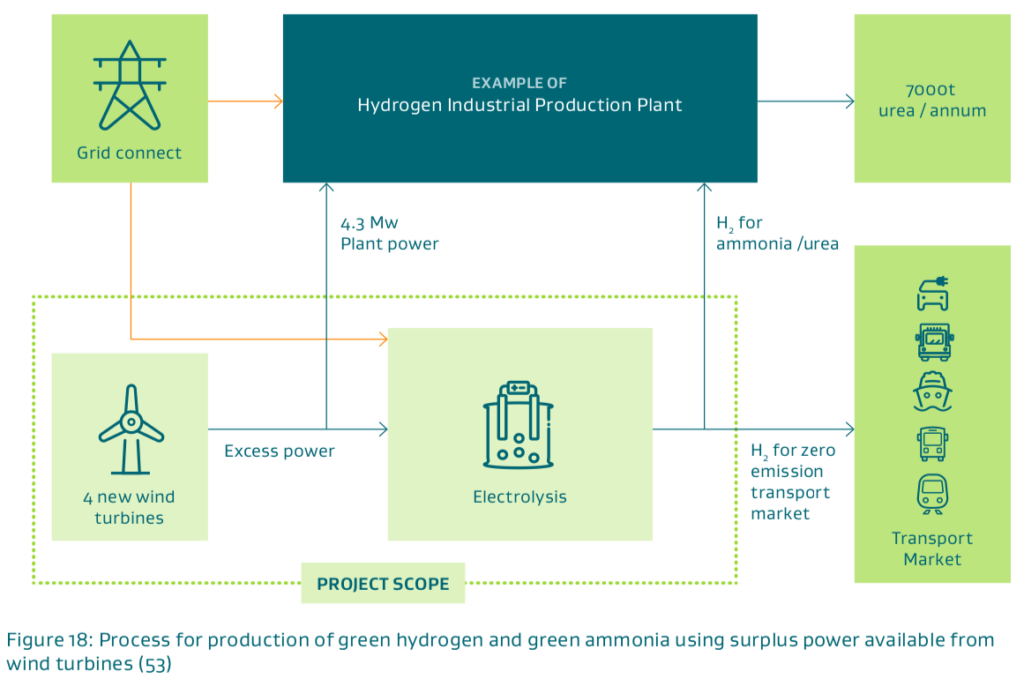Green ammonia plants win financing in Australia and New Zealand
By Trevor Brown on April 09, 2020
In recent weeks, governments in Australia and New Zealand have announced major financial awards to accelerate development of local green ammonia plants. In Australia, ARENA awarded AU $995,000 (US $0.6 million) to Yara and ENGIE for their solar ammonia pilot at Yara Pilbara. In New Zealand, the Provincial Growth Fund gave NZ $19.9 million (US $11.3 million) to Ballance-Agri Nutrients and Hiringa Energy for their wind-fed ammonia plant at Kapuni.
Both projects will demonstrate that an existing fossil ammonia plant can be decarbonized in increments. Renewable hydrogen can be introduced in small amounts, displacing only a fraction of the plant’s natural gas consumption but demonstrating and de-risking the technologies. Then, the renewable energy farms and electrolyzers can be scaled-up in stages, eventually replacing all the natural gas requirements and completing the conversion of a fossil asset to a renewable asset.
Yara and ENGIE in the Pilbara
The Yara-ENGIE feasibility study, which has a total budget of AU $3.76 million, aims “to identify the optimal scale of solar power generation, feeding multi-megawatt electrolysers,” to introduce the first renewable hydrogen into the existing ammonia plant. (As we reported last year, the engineering to tie-in a new hydrogen feed has already been completed, during the 2018 turnaround, so the ammonia plant is ready and waiting to be connected to electrolyzers.)
In collaboration with global energy company ENGIE, the Yara Pilbara Renewable Ammonia Feasibility Study will investigate the feasibility of producing renewable hydrogen via electrolysis powered by onsite solar PV. Yara’s objective is that approximately three per cent of the hydrogen blend will be renewable hydrogen. The blended hydrogen will subsequently be converted to ammonia and sold for further processing into domestic and international markets …
The study will be the first step on the path to achieving commercial scale production of renewable hydrogen and ammonia for export. In the long term, Yara is aiming to produce hydrogen and ammonia entirely through renewable energy. This approach will allow Yara to avoid any major augmentation to the existing plant and therefore minimise the cost and time needed to produce renewable ammonia.
ARENA website, Yara Pilbara Renewable Ammonia Feasibility Study, February 2020
The Pilbara plant has an ammonia capacity of 800,000 tons per year, so greening 3% of the hydrogen would deliver 24,000 tons per year of green ammonia. (Note that the ARENA website mistakenly suggests that the project would produce 30,000 tons of hydrogen; by my estimation, this is likely to be closer to 4,000 or 5,000 tons of hydrogen, depending on the final scale of the electrolyzers.)
Of course, to sell 100% green ammonia that comes out of a Haber-Bosch plant fed by 97% fossil hydrogen, a low-carbon certification and verification scheme will be essential.
At the AEA-Australia conference in August 2019, Yara Pilbara plant manager Chris Rijksen gave a presentation entitled “Green hydrogen feed for Haber Bosch ammonia synthesis.” Looking beyond this initial feasibility study, he described the real work of implementing the green hydrogen feed as a “potential ~$200 million demonstration project.” And that’s just Phase 0.

Phase 1 would be an expansion of the solar hydrogen feed, increasing to 20% of the Pilbara plant’s capacity, which would be roughly 180,000 tons per year of green ammonia. Phase 2 sees a bigger expansion of solar hydrogen and construction of a new, dedicated green ammonia plant. Phase 3 sees continued scale-up of solar hydrogen production, reaching a total capacity of 720,000 tons per year of green ammonia by 2030.
Yara’s goal is to ensure we will be the market shaper for green ammonia and low carbon fertiliser production.
Yara announcement, ARENA announces funding for Yara Pilbara and ENGIE’s feasibility study on a renewable hydrogen to ammonia solution in fertiliser production, February 21, 2020
Ballance and Hiringa in Taranaki
In New Zealand, fertilizer producer Ballance Agri-Nutrients is working with hydrogen developer Hiringa Energy on a similar start-small, aim-big project. As we reported in October 2019, after the project was first announced, 16 MW of wind turbines would produce green hydrogen, decarbonizing about 2% of the Kapuni ammonia-urea plant capacity.
For Ballance, the manufacture of green ammonia-urea will offset up to 12,500 tonnes of carbon emissions and avoid the import of 7,000 tonnes of urea from the Middle East and Asia.
Ballance announcement, Hiringa & Ballance welcome government support for world-first green energy project, March 6, 2020
According to the 2019 announcement, the project had a “completion date” of 2021; these new funds announced last month are intended “to accelerate the construction.”
The Government is investing $19.9 million [USD ~11 million] through the Provincial Growth Fund in a game-changing hydrogen energy facility in South Taranaki, Deputy Prime Minister Winston Peters announced today …
“The Kapuni plant is a significant contributor to South Taranaki’s economy and this project will create around 50 jobs during construction and an additional seven jobs after construction,” said Mr Peters.
New Zealand government announcement, PGF investment in green hydrogen, March 6, 2020
The Kapuni project is estimated to have a total cost of NZ $50 million (US $30 million), and it is one of the first to establish the narrative that green ammonia represents an economic opportunity. As other projects around the world scale up to levels that can support meaningful employment and regional development, they will follow this lead.
The $50 million Green Hydrogen project at Kapuni has the potential to be a catalyst for New Zealand’s transition to a sustainable, hydrogen-based transport network. The project will support significant regional economic growth through procurement, employment and opportunities for local contractors, as well as leveraging existing energy sector infrastructure and expertise in Taranaki.
Hiringa Energy announcement, Hiringa & Ballance welcome government support for world-first green energy project, March 6, 2020

The Kapuni green ammonia-urea plant is a key regional project that was outlined in the H2 Taranaki Roadmap launched by the Prime Minister, Jacinda Ardern, as well as in the government’s green paper A Vision for Hydrogen in New Zealand, both published in 2019.

Other elements of the hydrogen roadmap in Taranaki include blue hydrogen production (from natural gas, with carbon dioxide sequestration), offshore hydrogen production, green methanol production, hydrogen fueled trains, buses, and trucks, and hydrogen export.
The Kapuni green ammonia-urea plant will serve as the anchor for large-scale renewable hydrogen deployment in New Zealand, and it will make all these other possibilities for green hydrogen more feasible.